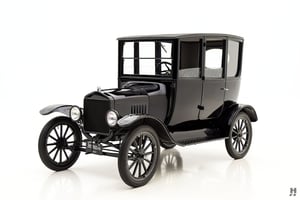 In our last article about The History Of The Automobile, we told the story of how a young Henry Ford left his home on a Michigan farm to become a professional engineer and inventor, tinkering with gasoline-propelled vehicles and various methods of production until his ambitions were realized. His dream was to create an automobile that was durable, easy to maintain, and affordable to the average, working-class American. He is quoted as saying that he wanted to, "...build a car for the great multitude...so low in price that no man making a good salary will be unable to own one." A noble vision on Ford's part. However, the production of such an invention would require a significant amount of old-school trial and error.
In our last article about The History Of The Automobile, we told the story of how a young Henry Ford left his home on a Michigan farm to become a professional engineer and inventor, tinkering with gasoline-propelled vehicles and various methods of production until his ambitions were realized. His dream was to create an automobile that was durable, easy to maintain, and affordable to the average, working-class American. He is quoted as saying that he wanted to, "...build a car for the great multitude...so low in price that no man making a good salary will be unable to own one." A noble vision on Ford's part. However, the production of such an invention would require a significant amount of old-school trial and error.
Ford conceived a series of automobiles, beginning with the Model A and ending in 1908 with the twentieth model intended for production. Ford named it the Model T, after the twentieth letter in the alphabet. Despite the lack of creativity in its naming process, Ford's newest invention would alter the course of American history by contributing to the growth of a strong middle class, driving an influx of immigrants and rural peoples to cities, influencing American culture, and revolutionizing industrial mass production.
Read More




 We live in a highly subjective world. Indeed, one might say the entire human experience is an emotional and subjective one. But facts are not. People may use facts incorrectly, or even come up with false data in order to prove a point, but real facts do not pretend to be anything that they're not. They don't even exist for humans to use or interpret; in essence, they simply exist to hold the universe together.
We live in a highly subjective world. Indeed, one might say the entire human experience is an emotional and subjective one. But facts are not. People may use facts incorrectly, or even come up with false data in order to prove a point, but real facts do not pretend to be anything that they're not. They don't even exist for humans to use or interpret; in essence, they simply exist to hold the universe together.  As the cold of the winter thaws, so do our vehicle and its structural components. The Spring is the perfect time to provide your automobile with a little tender love and care so it may achieve peak performance before hitting the highway.
As the cold of the winter thaws, so do our vehicle and its structural components. The Spring is the perfect time to provide your automobile with a little tender love and care so it may achieve peak performance before hitting the highway.

 The #1 concern of Fleet Services is the safety of our clients. We strive to educate on the topic with our blog series, Driver Safety Tips, as well as providing convenient ways to contact our fleet professionals to answer any questions or concerns a driver may have. If a car does break down on the road, we provide 24/7/365 emergency roadside assistance. However, mechanical failures and environmental conditions are NOT the primary cause of car accidents. With smartphone technology constantly buzzing in every driver's pocket and tempting people with the concept of instant gratification, Fleet has recognized a need for advocates that teach & influence drivers to avoid distractions while behind the wheel.
The #1 concern of Fleet Services is the safety of our clients. We strive to educate on the topic with our blog series, Driver Safety Tips, as well as providing convenient ways to contact our fleet professionals to answer any questions or concerns a driver may have. If a car does break down on the road, we provide 24/7/365 emergency roadside assistance. However, mechanical failures and environmental conditions are NOT the primary cause of car accidents. With smartphone technology constantly buzzing in every driver's pocket and tempting people with the concept of instant gratification, Fleet has recognized a need for advocates that teach & influence drivers to avoid distractions while behind the wheel.  In our last article about The History Of The Automobile, we told the story of how a young Henry Ford left his home on a Michigan farm to become a professional engineer and inventor, tinkering with gasoline-propelled vehicles and various methods of production until his ambitions were realized. His dream was to create an automobile that was durable, easy to maintain, and affordable to the average, working-class American. He is quoted as saying that he wanted to, "...build a car for the great multitude...so low in price that no man making a good salary will be unable to own one." A noble vision on Ford's part. However, the production of such an invention would require a significant amount of old-school trial and error.
In our last article about The History Of The Automobile, we told the story of how a young Henry Ford left his home on a Michigan farm to become a professional engineer and inventor, tinkering with gasoline-propelled vehicles and various methods of production until his ambitions were realized. His dream was to create an automobile that was durable, easy to maintain, and affordable to the average, working-class American. He is quoted as saying that he wanted to, "...build a car for the great multitude...so low in price that no man making a good salary will be unable to own one." A noble vision on Ford's part. However, the production of such an invention would require a significant amount of old-school trial and error.  "My minivan sold for how much?" My client asked, flashing a look of delight, surprise and slight disbelief. We politely reassured her that, yes, her para-transit minivan was sold at the previous week's
"My minivan sold for how much?" My client asked, flashing a look of delight, surprise and slight disbelief. We politely reassured her that, yes, her para-transit minivan was sold at the previous week's 